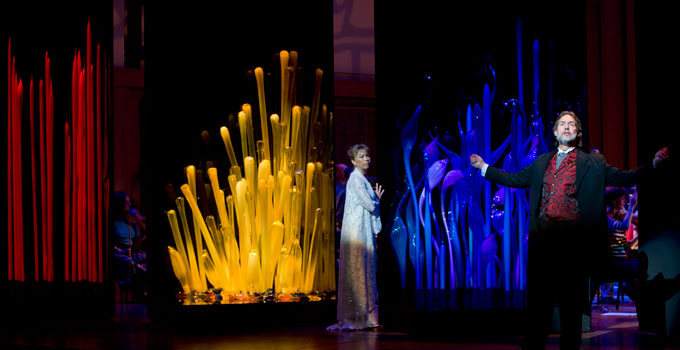Beethoven and Bartok
by Jan Jezioro

The Miró Quartet at UB and Bluebeard at the BPO
Beethoven is back, and Buffalo’s got him
OK, sure, Beethoven is not Clark Gable, and Buffalo is certainly not Greer Garson, but a play on the teaser tagline for the first post-World War II movie featuring these two movie star greats is not at all beyond the point. After all, the Department of Music at the University at Buffalo will be hosting the 59th season of the presentation of the complete Slee/Beethoven String Quartet Cycle with the Miró Quartet this weekend. While there are indeed many cultural gems to celebrate in our fair city, one of the very most significant for classical music lovers is this annual series made possible by the generosity of the late Frederick and Alice Slee. We are very lucky in this town, since while many of the great metropolises in the world have occasionally hosted a performance of the complete Beethoven cycle, Buffalo remains unique in that an annual performance of the greatest collection of string quartets has been a mainstay of the local musical scene for almost six decades.
The widely acclaimed Miró Quartet, no strangers to Buffalo audiences, having appeared on the Buffalo Chamber Music Society’s series in 2003 and 2006, will perform the first three concerts in the cycle at Slee Hall on the UB Amherst campus this Friday and Saturday at 7:30pm, and Sunday at 3pm. Now in their 18th year, the Miró Quartet is consistently praised for their deeply musical interpretations and exciting performances.
Tickets: $15/10; free for UB students. Information: www.slee.buffalo.edu
Bartok’s Bluebeard and Chihuly
On Wednesday, October 1 at 7pm Buffalo Philharmonic Orchestra music director JoAnn Falletta will conduct the orchestra’s first-ever concert performance of Béla Bartók’s one act opera, Bluebeard’s Castle, as the kickoff to the third season of the BPO’s “Know the Score” series. This production is a must-see event, both for any lover of 20th century opera and also for any admirer of the fantastical glass artistry produced by the Seattle-based studio of Dale Chihuly, since six massive examples of his work will be featured in the staging of Bartok’s opera.
Dale Chihuly’s connection to Western New York reaches back to 1975 when he was one of the many artists who enjoyed a creative residency at Artpark, which had opened the previous year. Later, in 1997, the Albright Knox mounted a huge, overwhelmingly popular exhibition of his works. In a recent documentary film about his career, Chihuly explained how his time at Artpark allowed him to discover the benefits of incorporating his glass sculptures into natural settings, a technique that has since become a trademark. It is always sadly nostalgic to remember what Artpark had once been—a wonderful incubator for both the fine arts and an innovative venue for opera, ballet and classical music generally— and what it has since become, a venue devoted almost exclusively to pop and rock music.
Bartok composed his only opera to a libretto by his friend Béla Balázs, a Hungarian-Jewish film critic, aesthete, writer and poet, who had been inspired by the French folk tale “La Barbe bleue” the most famous surviving version of which was published by Charles Perrault in 1659. Balázs had originally offered the libretto to his roommate, Zoltán Kodály, Bartók’s companion in their epic effort to record all examples of Hungarian folk music. Seeking a new musical language based on the naturalness and spontaneity of Hungarian folk music, Bartók made extensive use of the folk music influenced technique of “parlando rubato” which intensified the spoken inflection of his native language, allowing an absolute rhythmic freedom in setting texts.
Bluebeard’s Castle is an intensely dark, psychological drama with Bluebeard and his new wife Judith as the only characters. Bartók was heavily influenced by Debussy’s Pelléas et Mélisande in composing his work, which like Debussy’s is almost entirely without dramatic action, being symbolic rather than specific. It might also be described as impressionistic, in that it is similarly concerned with revealing through musical means just what is behind each of the seven doors that Judith enthusiastically begs her new husband to give her the key to open, when she arrives at his gloomy castle for the first time. The change of her mood from excitement to horror, to a final acceptance of the inevitable, will be mirrored in the six, 18 foot high glass sculptures that will swing into view as the huge, black doors are opened.
Bass-baritone Charles Robert Austin, who previously appeared with the BPO to critical acclaim, originated the role of Bluebeard for the Seattle Opera’s 2007 production that first utilized this staging and has since made the role a specialty. Mezzo-soprano Michelle DeYoung, who has recorded Mahler’s Kindertotenlieder with former BPO music director Michael Tilson Thomas, will be reprising her role at a Dallas Symphony production in November.
Tickets: $29/$10 student. Information: www.bpo.org
blog comments powered by Disqus
|
Issue Navigation> Issue Index > v13n39 (Week of Thursday, September 25) > Beethoven and Bartok This Week's Issue • Artvoice Daily • Artvoice TV • Events Calendar • Classifieds |









 Current Issue
Current Issue